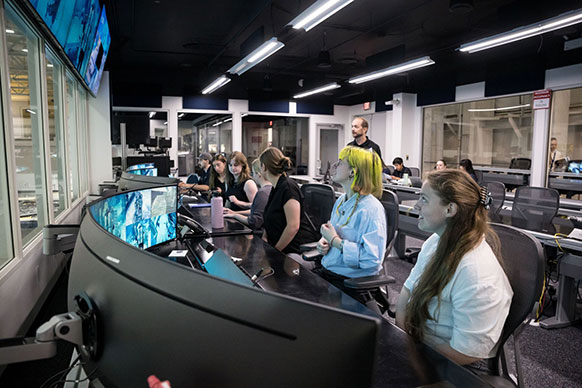Space Cowgirls Engineering Team Represented UW in NASA Micro-g NexT Design Challenge
Published October 23, 2025

Juneau Paulsen (far right) and Ellie Taplin (left of Paulsen), both UW mechanical engineering majors, help direct the diver in NASA’s Neutral Buoyancy Laboratory (NBL) from the NBL control room. The two are part of the Space Cowgirls’ engineering team that represented UW in in the NASA Micro-g NexT Design Challenge. (Helen Arase Vargas Photo)
The University of Wyoming has been sending teams of undergraduate engineers to NASA
for several years now, and this year continued that growing legacy of engineering
innovation. After successfully completing Phase 1 of the Micro-g Neutral Buoyancy
Experiment Design Teams (NExT) engineering design challenge, one UW team -- the Space
Cowgirls -- moved on to Phase 2.
The team was composed of mechanical engineering majors Serina Abriola, of Sewell,
N.J.; Adrianna France, of Fort Collins, Colo.; Annalise Gade, of Worland; Alexa Mazur,
of Lander; Juneau Paulsen, of Baldwin, Wisc.; and Elizabeth Taplin, of Longmont, Colo.
This all-female team undertook NASA’s challenge to design, build and test a “Star
Shooter” capable of attaching soft goods between old components and new components
for thermal protection at the boundary between the two. The tasks outlined in the
design challenge are intended to address real-world needs in space travel and exploration.
In this case, such a device might be used during an EVA (an extra-vehicular activity,
such as a spacewalk) on the International Space Station.
The team’s process for completing its device included many rounds of brainstorming;
modeling with the program SolidWorks; 3D printing component parts to test them; and
then producing multiple prototypes as the team adjusted its design and methods.
“Our main takeaways from the trip were that engineering is a long process with many
bumps along the way,” Taplin says. “But every failure helps you learn and improve
on the next iteration.”
That iterative process and their organizational approach, dividing the work into subunits
within the team to focus on modeling, 3D printing, outreach and financial management,
respectively, helped the Space Cowgirls work well as a team and contributed to their
ultimate success. That success included progressing from design to building and testing
in the competition, with a trip to Houston in early June for device testing by professional
divers in a real-world underwater space simulation environment. During the test, students
had the task of directing the divers on the use of their device from the lab’s control
room.
“Travel to the NASA Neutral Buoyancy Laboratory in Houston was a dream opportunity,”
Mazur says. “The realization that we were working with real NASA scientists and engineers
brought on the realization that, as a woman in engineering, we could work directly
with some of the most important and impactful science of our generation. This experience
has caused us to strive for the highest of dreams and believe in ourselves as young,
aspiring engineers.”
In addition to the invaluable hands-on learning experience and professional networking
opportunities afforded by the challenge, the team found the full process itself --
working as a team, producing a product from idea to functional object, budgeting and
outreach --intensely rewarding and valuable.
“We would like to thank our adviser, the engineering department, as well as the Wyoming Space Grant Consortium. Funding by organizations like them make this competition and experience possible,” Abriola says.

